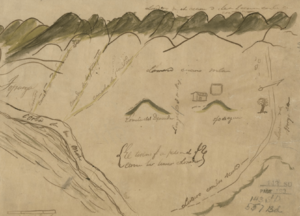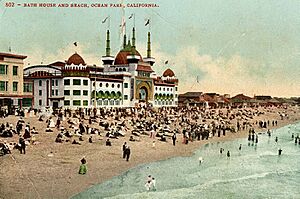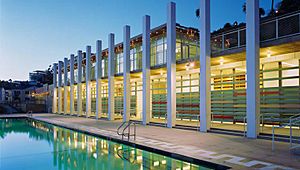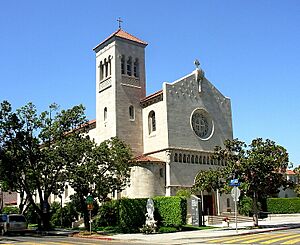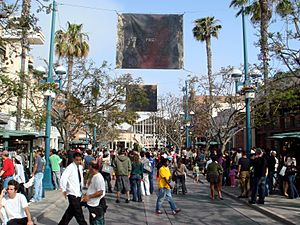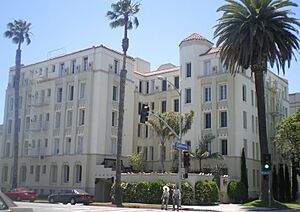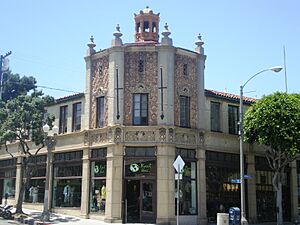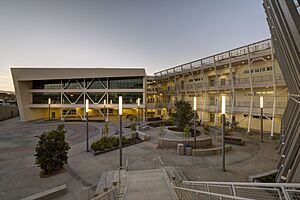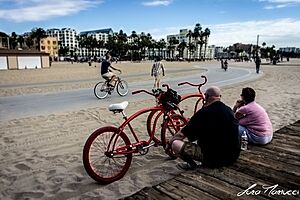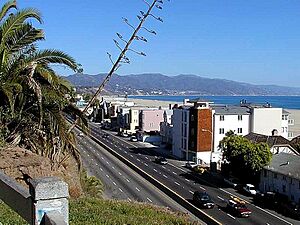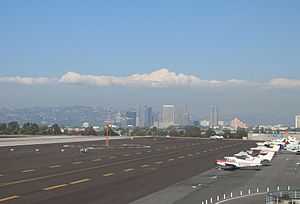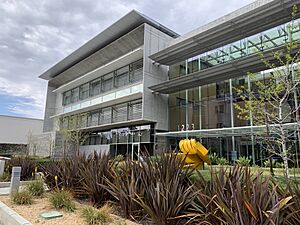Santa Monica, California facts for kids
Quick facts for kids
Santa Monica, California
|
||
|---|---|---|
|
Georgian Hotel
Sovereign Hotel
|
||
|
||
| Nickname(s):
SaMo
|
||
| Motto(s):
Populus felix in urbe felice
(Latin for 'Happy people in a happy city' / 'Fortunate people in a fortunate land') |
||
| Country | United States | |
| State | California | |
| County | Los Angeles | |
| Spanish encampment | August 3, 1769 | |
| Incorporated | November 30, 1886 | |
| Named for | Saint Monica | |
| Government | ||
| • Type | Council–manager | |
| Area | ||
| • Total | 16.00 sq mi (41.43 km2) | |
| • Land | 8.41 sq mi (21.80 km2) | |
| • Water | 7.58 sq mi (19.64 km2) | |
| Elevation | 105 ft (32 m) | |
| Population
(2020)
|
||
| • Total | 93,076 | |
| • Rank | 92nd in California | |
| • Density | 11,067/sq mi (4,273/km2) | |
| Time zone | UTC−8 (Pacific) | |
| • Summer (DST) | UTC−7 (PDT) | |
| ZIP Codes |
90401–90411
|
|
| Area codes | 310/424 | |
| FIPS code | 06-70000 | |
| GNIS feature IDs | 1652792, 2411825 | |
Santa Monica is a city in Los Angeles County, California. It sits right on the coast of Santa Monica Bay. In 2020, about 93,076 people lived there. Santa Monica is a very popular place to visit because of its great weather, beautiful beaches, and many hotels. It also has a strong economy, with big companies like Hulu, Activision Blizzard, and Universal Music Group having their main offices there.
The city's history goes back to a large ranch called Rancho San Vicente y Santa Mónica in 1839. Later, in 1875, John P. Jones and Robert Baker helped found Santa Monica. It officially became a city in 1886. In the late 1800s and early 1900s, it grew into a famous beach resort. Places like Palisades Park, the Santa Monica Pier, and the Hotel Casa del Mar were built to attract visitors.
Contents
History
Early History
The Tongva people were the first to live in the Santa Monica area. They had a village called Comicranga.
The first non-native people to arrive were explorers led by Gaspar de Portolá on August 3, 1769. They camped near where Barrington and Ohio Avenues are today.
There are two stories about how Santa Monica got its name. One says it was named after Saint Monica, but her special day is May 4. Another story says explorer Juan Crespí named it after two springs, the Kuruvungna Springs. He thought they looked like the tears Saint Monica cried for her son.
In 1839, a large ranch called Rancho San Vicente y Santa Mónica was given to Francisco Sepúlveda II. A small community of Californio people, mostly cowboys, lived and worked on this ranch.
Becoming a City
After California became part of the United States in 1848, Santa Monica started to grow. In the 1870s, a railroad connected Santa Monica to Los Angeles. This made it easier for people to visit. The city's first town hall was built in 1873.
In the early 1900s, fun piers became popular. The Pacific Electric Railway brought many people from the Los Angeles area to the city's beaches.
Many Japanese and Chinese people lived and worked in Santa Monica and Venice around this time. Japanese fishermen were very important to the local economy.
Donald Wills Douglas Sr. opened his Douglas Aircraft Company plant at Clover Field (now Santa Monica Airport) in 1922. In 1924, four planes built by Douglas took off from here to try and fly around the world. Two planes made it back after flying 27,553 miles in 175 days! A huge crowd of 200,000 people welcomed them home. The Douglas Company stayed in Santa Monica until the 1970s.
During the Great Depression in the 1930s, many people in Santa Monica lost their jobs. The government's Works Project Administration (WPA) helped by building several important buildings. These included the City Hall, the main Post Office, and Barnum Hall at Santa Monica High School.
Modern Era
During World War II, Douglas Aircraft grew a lot, employing 44,000 people by 1943. To protect the factory from air attacks, movie set designers from Warner Bros. used clever camouflage to hide it. The RAND Corporation, a famous research group, started as a project of Douglas Company in 1945. It became its own company in 1948 and is still in Santa Monica today.
The building of the Santa Monica Civic Auditorium in 1958 and the Santa Monica Freeway in 1966 changed the city. They led to the removal of some older neighborhoods.
Beach volleyball is thought to have started in Santa Monica in the 1920s.
Santa Monica has two hospitals: Saint John's Health Center and Santa Monica-UCLA Medical Center. The city also has several local newspapers.
Geography
Santa Monica is built on a gentle slope that goes down towards Ocean Avenue and the south. Tall cliffs separate the northern part of the city from the beaches. Santa Monica is next to Pacific Palisades to the north and Venice to the south. To the west, it has a 3-mile coastline along Santa Monica Bay. To the east are the Los Angeles areas of West Los Angeles and Brentwood.
Climate
Santa Monica has a coastal Mediterranean climate. This means it has mild, wet winters and warm, dry summers. The city gets about 310 sunny days each year.
Because it's right on the big Santa Monica Bay, morning fog is common in May, June, July, and early August. People in Los Angeles call this the "May Gray," "June Gloom," and even "Fogust." The fog usually burns off by noon, but sometimes it stays cloudy and cool all day in June. The beach area is often 5 to 10 degrees Fahrenheit cooler than inland areas in summer. In winter nights, it can be 5 to 10 degrees warmer.
The hottest temperatures usually happen in September. In winter, hot, dry winds called Santa Anas are common. It rarely gets very cold.
The rainy season is from late October to late March. There is very little rain during the rest of the year. It has never snowed or frosted in Santa Monica, but it has hailed.
Cool breezes from the ocean keep the air fresh and clean in Santa Monica. This means smog is less of a problem here than in other parts of Los Angeles. However, from September to November, the Santa Ana winds can bring smoggy, hot air from inland to the beaches.

Environment
Santa Monica is a leader in being an environmentally friendly city. In 1994, it was one of the first cities to have a plan for sustainability. This plan helps reduce waste and save water.
Most of the city's public vehicles, including buses, use clean fuels. This makes it one of the largest fleets of its kind in the country. In 2019, Santa Monica started using 100% renewable energy for its electricity. The city also aims to cut carbon emissions by 80% by 2030.
A special facility called SMURFF cleans water that would normally flow into the bay. This cleaned water is then sold back to people in the city to be reused. The city also has programs to help residents save water, like offering money back if they change their lawns to gardens that need less water.
Santa Monica has a "green building code." This means new buildings are built to high environmental standards. The city's Main Library, for example, collects rainwater from its roof to water its plants.
Since 2009, Santa Monica has been working on a "Zero Waste" plan. The goal is to send 95% less waste to landfills by 2030. This includes a program to compost food waste from restaurants.
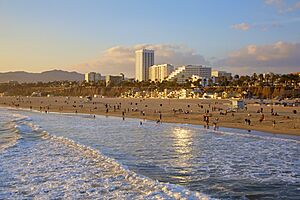
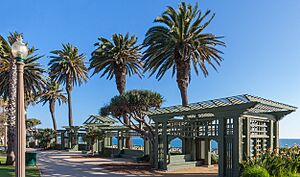
Demographics
In 2020, Santa Monica had a population of 93,076 people. Most residents were White (68.1%), followed by Asian (9.2%) and Black or African American (4.1%). About 14.6% of the population was Hispanic or Latino.
The city has many different types of households. About 27.1% of homes are owned by the people living in them, and 72.9% are rented. Santa Monica is known for having a highly educated population, with many residents holding college degrees.

Economy

Santa Monica is home to the main offices of many well-known companies. These include Hulu, Illumination (who make animated movies), Lionsgate (a film studio), Universal Music Group (a music company), and TOMS Shoes. The Recording Academy, which gives out the annual Grammy Awards, is also based here.
Many video game companies are in Santa Monica, making it a big center for the gaming world. Some of these include:
- Activision Blizzard (known for games like Call of Duty)
- Naughty Dog (creators of Crash Bandicoot, Jak & Daxter, Uncharted, and The Last of Us)
- Santa Monica Studio (creators of the God of War games)
- Treyarch (another Call of Duty developer)
Santa Monica is also a key part of "Silicon Beach," an area in Los Angeles with many new startup companies that get funding from investors.
Top Employers
The biggest employers in Santa Monica in 2022 were:
| # | Employer | # of Employees |
|---|---|---|
| 1 | City of Santa Monica | 2,059 |
| 2 | Santa Monica – UCLA Medical Center | 1,965 |
| 3 | Santa Monica College | 1,865 |
| 4 | Snap Inc. | 1,667 |
| 5 | Universal Music Group | 1,400 |
| 6 | Saint John's Health Center | 1,368 |
| 7 | Santa Monica-Malibu Unified School District | 1,358 |
| 8 | Hulu | 1,320 |
| 9 | Oracle Corporation | 950 |
| 10 | Activision | 919 |
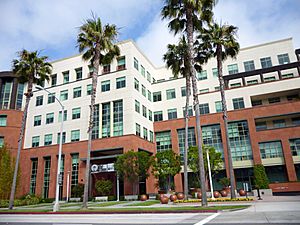
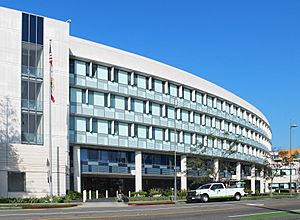
Arts and Culture
The Santa Monica Looff Hippodrome (a carousel) is a very old and important building. It's located on the Santa Monica Pier, which was built in 1909. The La Monica Ballroom on the pier used to be the biggest ballroom in the United States!
The Santa Monica Civic Auditorium was a famous place for music concerts and even hosted the Academy Awards in the 1960s. McCabe's Guitar Shop is a popular place to hear acoustic music. The Santa Monica Playhouse is a well-known theater in the city.
Bergamot Station is a large area with many art galleries. You can also visit the California Heritage Museum and the Angels Attic dollhouse and toy museum.
The New West Symphony performs at Barnum Hall. Santa Monica also hosts the yearly Santa Monica Film Festival.
The city's oldest movie theater is the Majestic, which opened in 1912. The Aero Theater and Criterion Theater were built in the 1930s and still show movies today.
Shopping Districts
Santa Monica has three main shopping areas: Montana Avenue, the Downtown District, and Main Street. Each has its own special feel. Montana Avenue has fancy shops and restaurants. Main Street has a mix of unique clothing stores and eateries.
The Downtown District is home to the Third Street Promenade. This is a major outdoor shopping area where only people can walk, not cars. It's a great place to stroll, shop, and watch street performers.
At the end of the Promenade is the Santa Monica Place. This is a modern shopping mall with stores like Bloomingdale's and Nordstrom, and it has outdoor spaces for dining and entertainment.
Public Library System
The Santa Monica Public Library has a main library downtown and four smaller branches in different neighborhoods.
Sports
Parts of Santa Monica were used for the marathon races during the 1984 Summer Olympics. The Santa Monica Track Club has many famous track athletes, including Olympic gold medalists.
Santa Monica is also home to the Santa Monica Rugby Club, a semi-professional team.
In the 2028 Summer Olympics, Santa Monica will host beach volleyball and surfing events!
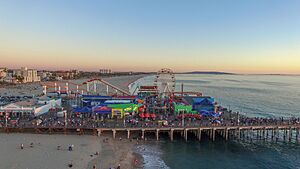
Parks and Recreation
Palisades Park runs along the cliffs overlooking the Pacific Ocean. It's a popular place to walk and enjoy the ocean views. It has public art, a totem pole, a camera obscura, benches, and picnic areas.
Tongva Park is a 6-acre park near the ocean. It has an overlook, an amphitheater, a playground, gardens, and fountains.
The Santa Monica Stairs are a long, steep set of steps that go down into Santa Monica Canyon. They are a popular spot for outdoor workouts.
Ishihara Park opened in 2017 and is a green space between the Los Angeles Metro Rail and nearby homes.
Education
Public Schools
The Santa Monica–Malibu Unified School District runs the public schools. This includes elementary, middle, and high schools. There's also a special school called SMASH for K-8 students, which has team teachers and multi-age classrooms.
Private Schools
Private schools in Santa Monica include Crossroads School and Saint Monica Catholic High School.
Post-Secondary Education
Santa Monica College is a community college that opened in 1929. Many students from SMC transfer to the University of California system. It has about 30,000 students each year.
The Frederick S. Pardee RAND Graduate School, connected to the RAND Corporation, is the largest school in the U.S. that gives out PhDs in public policy. The Art Institute of California – Los Angeles is also in Santa Monica.
Infrastructure
Transportation
Bicycles
Santa Monica is a bike-friendly city. It has a bike action plan and started a bicycle sharing system in 2015. The Marvin Braude Bike Trail runs through the city. Santa Monica has won awards for being a Bicycle Friendly Community. The city is working to have more people use bikes for transportation by adding more bike lanes and paths.
Highways
The Santa Monica Freeway (Interstate 10) starts in Santa Monica near the ocean and goes east. This freeway is one of the busiest highways in North America. It crosses seven more states and ends in Florida. In Santa Monica, a sign calls it the Christopher Columbus Transcontinental Highway.
State Route 2 (Santa Monica Boulevard) also starts in Santa Monica and goes northeast through Los Angeles County. Santa Monica is also the western end of Historic U.S. Route 66.
Bus
Santa Monica has its own bus service called the Big Blue Bus. It serves Santa Monica and much of West Los Angeles, including University of California, Los Angeles (UCLA).
Light Rail
The Expo Line light rail connects Santa Monica to Culver City and Downtown Los Angeles. Service started in May 2016. Santa Monica has three Metro stations: Downtown Santa Monica, 17th Street/SMC, and 26th Street/Bergamot. A trip from Downtown Santa Monica to Downtown Los Angeles takes about 46 minutes.
This train line uses the old path of the Pacific Electric Railway's Santa Monica Air Line. This line used to carry both freight and passengers between Los Angeles and Santa Monica.
Airport and Ports
The city owns and runs a small airport called Santa Monica Airport. It has been important for many aviation achievements. For bigger commercial flights, residents use LAX, which is a few miles south.
Santa Monica relies on the Port of Long Beach and the Port of Los Angeles for international shipping.
Other Transportation
Since 2018, Santa Monica has allowed companies like Bird, Lime, Lyft, and Jump Bikes to operate dockless scooter-sharing systems in the city.
Emergency Services
Santa Monica has two main hospitals: UCLA Medical Center, Santa Monica and Saint John's Health Center. The Santa Monica Fire Department has four fire stations that respond to medical and fire emergencies. They have paramedic engines, a hazardous materials team, and a search and rescue team. The Santa Monica Police Department provides law enforcement services.
Internet Services
Santa Monica has a municipal wireless network that offers free Wi-Fi hotspots around the city.
Notable People
Sister Cities
 Mazatlán, Mexico
Mazatlán, Mexico Hamm, Germany
Hamm, Germany Fujinomiya, Japan
Fujinomiya, Japan
See also
 In Spanish: Santa Mónica (California) para niños
In Spanish: Santa Mónica (California) para niños









